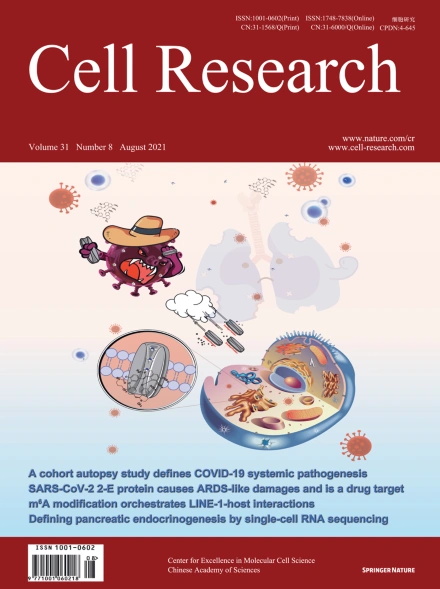
Advanced Search
Submit Manuscript
Advanced Search
Submit Manuscript
Volume 31, No 8, Aug 2021
ISSN: 1001-0602
EISSN: 1748-7838 2018
impact factor 17.848*
(Clarivate Analytics, 2019)
Volume 31 Issue 8, August 2021: 861-865 |
RNA m6A modification orchestrates a LINE-1–host interaction that facilitates retrotransposition and contributes to long gene vulnerability
Feng Xiong1 , Ruoyu Wang1,2 , Joo-Hyung Lee1 , Shenglan Li3,4 , Shin-Fu Chen1 , Zian Liao1,2 , Lana Al Hasani1,2 , Phuoc T. Nguyen1,2 , Xiaoyu Zhu1 , Joanna Krakowiak1 , Dung-Fang Lee2,4,5,6 , Leng Han7 , Kuang-Lei Tsai1,2 , Ying Liu2,3,4 , Wenbo Li1,2,6,*
1Department of Biochemistry and Molecular Biology, McGovern Medical School, University of Texas Health Science Center, Houston, TX, USAThe molecular basis underlying the interaction between retrotransposable elements (RTEs) and the human genome remains poorly understood. Here, we profiled N6-methyladenosine (m6A) deposition on nascent RNAs in human cells by developing a new method MINT-Seq, which revealed that many classes of RTE RNAs, particularly intronic LINE-1s (L1s), are strongly methylated. These m6A-marked intronic L1s (MILs) are evolutionarily young, sense-oriented to hosting genes, and are bound by a dozen RNA binding proteins (RBPs) that are putative novel readers of m6A-modified RNAs, including a nuclear matrix protein SAFB. Notably, m6A positively controls the expression of both autonomous L1s and co-transcribed L1 relics, promoting L1 retrotransposition. We showed that MILs preferentially reside in long genes with critical roles in DNA damage repair and sometimes in L1 suppression per se, where they act as transcriptional “roadblocks” to impede the hosting gene expression, revealing a novel host-weakening strategy by the L1s. In counteraction, the host uses the SAFB reader complex to bind m6A-L1s to reduce their levels, and to safeguard hosting gene transcription. Remarkably, our analysis identified thousands of MILs in multiple human fetal tissues, enlisting them as a novel category of cell-type-specific regulatory elements that often compromise transcription of long genes and confer their vulnerability in neurodevelopmental disorders. We propose that this m6A-orchestrated L1–host interaction plays widespread roles in gene regulation, genome integrity, human development and diseases.
https://doi.org/10.1038/s41422-021-00515-8